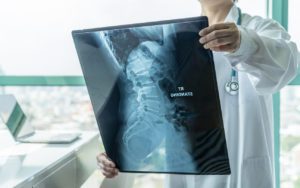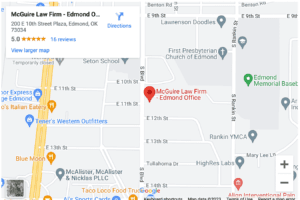Herniated Discs

Your back supports your body when you stand, walk, or sit. When it gets injured, you can suffer from pain, weakness, and a limited range of motion.
These symptoms can occur in regions other than your back. If your back injury includes herniated discs, your spinal cord can become inflamed. You could suffer symptoms throughout your body.
Here are some facts about herniated discs and the compensation you can seek for their symptoms.
What Is the Anatomy of the Back?

Your back must perform many functions. These functions often contradict each other. For example, your back must have the strength to hold up your body but the flexibility to allow you to bend and twist.
To accomplish these diverse tasks, your back incorporates several parts. Each of these parts performs a unique function. When you injure any of these parts, the entire system can become compromised.
Your back includes:
Vertebrae
The vertebrae provide structure. The average adult has 24 vertebrae.
Each vertebra has a cylinder-shaped body and wing-shaped processes. The bodies of your vertebrae align to form a column running up the center of your back.
This column resists compression and transfers the weight of your body to your hips and legs for support.
The processes of your vertebrae connect to ligaments that hold your vertebrae in place. The spinous processes also anchor tendons for your back muscles.
Intervertebral Discs
Discs sit between vertebrae. These discs cushion the vertebrae so that your vertebrae do not collide when you walk, run, or jump. They also allow the vertebrae to move smoothly when you twist and bend rather than grinding against each other.
The discs have two layers. The outer layer, called the annulus, is formed from rings of fibrous collagen and protein. The inner layer, called the nucleus, contains loose collagen and water to form a gel-like texture.
Spinal Cord
The body and processes of each vertebra enclose a space. When your vertebrae align, the spaces align to form the spinal canal. The spinal canal contains and protects the spinal cord and the meninges that surround it.
The spinal cord contains all of the nerves that connect your brain to your body below the neck. These nerves carry signals transmitted by charged ions. These electrical signals allow you to move your body almost instantaneously after your brain sends a signal.
Nerve roots branch off the spinal cord at each vertebra. These nerve roots carry signals to regions of your body. For example, the nerve roots that branch off the spinal cord in the neck vertebrae carry nerve signals to your shoulders, arms, hands, and fingers.
How Do Herniated Discs Happen?
Disc injuries can happen in a few ways:
Trauma
Trauma to your back or neck can damage the fibers making up the annulus of your discs. The fibers can tear or separate, compromising the strength and structure of your disc.
Car accidents cause a particular type of trauma often associated with herniated discs. When you collide with another car, your body hits your seat belt and your spine hyperextends. The same happens in other types of vehicles like trucks.
As you come to a stop, your spine snaps back and compresses. This hyperextension and compression can crush the discs.
Overuse
Stress on your back can create small cracks in the discs. Repetitive stress can cause these cracks to propagate before they can heal.
Disc injuries from overuse usually happen in workplaces where employees spend much of their time standing, walking, lifting, or carrying. Back pain from overuse injuries is a leading cause of missed work and workers’ compensation claims.
Degeneration
The fibrous disc tissue requires water to retain its flexibility. As people age, the discs dry out and become susceptible to deformation and cracking.
This also means that seniors have a higher risk of sustaining a disc injury in an accident. Since their discs have dried out, the fibers of the annulus can tear or separate more easily.
What Are the Types of Disc Injuries?
Disc injuries fall into two broad categories:
Herniated Discs
A herniated disc happens when the fibers of the annulus separate and allow the nucleus to protrude through the annulus. Because of the consistency of the nucleus, it does not leak out completely. Instead, it forms a bump on the side of the disc.
Bulging Discs
A bulging disc happens when the fibers of the annulus weaken but do not separate. As a result, the disc deforms from a cylinder shape into a barrel shape. Instead of developing a bump on the side of the disc, the entire wall of the annulus bulges out.
What Are the Effects of Bulging and Herniated Discs?
When a disc deforms, your back can become unstable. The damaged disc cannot cushion your vertebrae as effectively and may produce back pain as your back muscles experience greater-than-normal stresses.
But a much greater problem comes when the deformed disc protrudes into the spinal canal. Pressure on the spinal cord causes the nerves to inflame. When they inflame, they cannot carry signals correctly and may even misfire.
The spinal cord carries three types of nerve signals.
Autonomic nerve signals control your involuntary responses like temperature regulation, heart rate, and sexual arousal.
Motor nerve signals control your muscles to make voluntary movements. Sensory signals convey environmental information to the brain, such as skin pressure and temperature.
A spinal cord injury disrupts these signals, and you may notice:
- Pain that radiates to your shoulders, arms, hips, or legs
- Numbness or tingling in your extremities
- Muscle weakness
- Limited range of motion
- Loss of bowel or bladder control
These are the symptoms you could experience as a result.
What Compensation Is Available for Herniated Discs?
When your bulging or herniated disc was the result of someone else’s negligence, you can usually seek injury compensation. This compensation will cover your present and future economic losses. It will also cover your non-economic losses like pain and suffering.
Doctors have limited options for treating bulging and herniated discs. They can try to treat the nerve inflammation with anti-inflammatory injections. But this treatment will not fix the underlying disc damage.
Doctors can operate on the spine and remove the damaged disc. After removal, doctors fuse the adjacent vertebrae using plates and screws. This can relieve the disc pain, but it stresses the vertebrae.
Even with treatment, bulging or herniated discs can cause lifelong nerve damage. As a result, you could be entitled to substantial damages.
To learn more about the compensation you can recover for your herniated discs, contact McGuire Law Firm for a free consultation.

